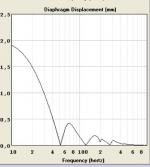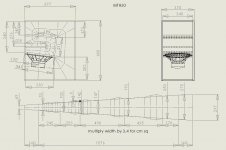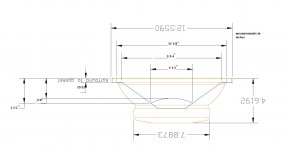They look great. Do you have any measurements, or even simply comments regarding their performance? Also, if it's not too much trouble, I'd love to know what drivers, handles, and connectors you used as well as any particular issues that you might have had during construction?
I love the stacking feet, I presume that they have been routed so that they can be stacked in either dimension?
I'd love to see more pictures, either build shots, or side/rear shots, if you have them.
At the risk of pushing my luck, have you weighed them?
As I say, they look great, you appear to know what you're doing and it would be great to hear field reports from people who have actually used them. I've seen plenty of discussion about MTH30 builds, and, of course, this thread has a lot of discussion of the THAM12 design, but I've seen very little about actual THAM12 builds.
tnx,
gs
Hi GS.
As i haven't really had the time to play with them (thet finished yesterday) i have no measurements, but i have an initial impression after a few minutes of listening. They sound very clean, punchy and precise. I heard them next to a commercial 2x15" reflex cab (NOVA Visio VS215) and there was a huge difference in sound quality. The THAMs just walked all over the reflex cab with lovely sounding bass.
After this coming weekend i can comment some more on the SPL the THAMs can produce.
I had them crossed at 45Hz with a 24dB BW slope and i think i might raise that to 50Hz in hope of getting rid of some cone movement. All in all i look forward to play around with different settings and i will of course post my findings.
Mine er loaded with PD.12SB30 drivers. All accessories can be found at Adam Hall. The rubber feat is 38x10. The handles is the smallest model they have (can't remember exact size). The pole mount is with 20mm thread. Connectors is standard round 4-pole neutrik.
Construction wise, to fit the handle i just moved the upper brace to the side. The pole mount is just mounted far enough back to not interfear with the internal panels.
All-in-all not anything speciel. BUT if you are to build with PD.12SB30 you have to make the cabinet a few mm. wider to make the driver fit!
You are right. There have been routed for feet on both sides and top/bottom. The way they are on the pic is only intended for transportation, as i want to use them laying on there sides.
Some building pics:
An externally hosted image should be here but it was not working when we last tested it.
Assembly
An externally hosted image should be here but it was not working when we last tested it.
Assembly
An externally hosted image should be here but it was not working when we last tested it.
Almost finished with the first cab
An externally hosted image should be here but it was not working when we last tested it.
After routing of the edges + test mounting of the drivers
An externally hosted image should be here but it was not working when we last tested it.
After 2 layers of paint. They could need some more though
An externally hosted image should be here but it was not working when we last tested it.
Mounting all fittings and drivers
An externally hosted image should be here but it was not working when we last tested it.
Done and quick test
EDIT: Just had them on the bathroom weight. It says 28kg each.
Last edited:
Hi GS.
I had them crossed at 45Hz with a 24dB BW slope and i think i might raise that to 50Hz in hope of getting rid of some cone movement. All in all i look forward to play around with different settings and i will of course post my findings.
Mine er loaded with PD.12SB30 drivers. All accessories can be found at Adam Hall. The rubber feat is 38x10. The handles is the smallest model they have (can't remember exact size). The pole mount is with 20mm thread. Connectors is standard round 4-pole neutrik.
Construction wise, to fit the handle i just moved the upper brace to the side. The pole mount is just mounted far enough back to not interfear with the internal panels.
Some building pics:
EDIT: Just had them on the bathroom weight. It says 28kg each.
Thanks so much, for a beginner who doesn't want to either make simple mistakes, or conversely, worry about the wrong things, your post was super helpful.
Assuming the Tham 12 simulation is correct, (which you could confirm with sine wave testing) the excursion minima is around 51 Hz.I had them crossed at 45Hz with a 24dB BW slope and i think i might raise that to 50Hz in hope of getting rid of some cone movement.
With a BW24 at 45 Hz the drivers are more likely running out of excursion in the 60-80Hz range, only way to reduce that is turn down the volume.
Attachments
Can only say that you are absolutely correct according to that simulation.
I will have to do some proper testing to find out how much power they can take without exceeding xmax.
As i am looking at the drivers moving it seems to me, that they sometimes move quiet alot, but is there an easy way to see/measure how much the cone is actually moving?
I will have to do some proper testing to find out how much power they can take without exceeding xmax.
As i am looking at the drivers moving it seems to me, that they sometimes move quiet alot, but is there an easy way to see/measure how much the cone is actually moving?
Assuming the Tham 12 simulation is correct, (which you could confirm with sine wave testing) the excursion minima is around 51 Hz.
With a BW24 at 45 Hz the drivers are more likely running out of excursion in the 60-80Hz range, only way to reduce that is turn down the volume.
So in 60-80hz it seems that the graph suggests that the output is less than 0.5mm, is that supposed to be 0.5cm? The driver has an xmax of 7mm so 0.5 cm would make more sense?
Perhaps I misunderstand something else?
Simply put a white dot on the cone, run sine waves through the cone, and compare the dot's peak to peak movement at various frequencies with a ruler.Can only say that you are absolutely correct according to that simulation.
I will have to do some proper testing to find out how much power they can take without exceeding xmax.
As i am looking at the drivers moving it seems to me, that they sometimes move quiet alot, but is there an easy way to see/measure how much the cone is actually moving?
When approaching Xmax (half of the peak to peak distance), make sure to not run sine waves for more than a few seconds, and leave at least double the time between tests as the individual tests take.
If you don't want the detail, use pink noise. If you raise the HP to 50 Hz and the cone is still over Xmax, you know the problem area is above Fb.
It is only driven at 2.83 volts, the figures are in mm, the comma is substituted for a period.So in 60-80hz it seems that the graph suggests that the output is less than 0.5mm, is that supposed to be 0.5cm? The driver has an xmax of 7mm so 0.5 cm would make more sense?
Perhaps I misunderstand something else?
The driver runs out of excursion before the voice coil burns
It is only driven at 2.83 volts
Ok, of course, that's what I missed.
Hi Chaps,
When and where did you buy your PD drivers? For accuracy I have to know if you have an old or a new version.
There were purchased from thomann in january. Guess they are the new model.
Art: I may have to try that. Maybe the problem isn't as big as i first thought. I'm just not used to looking at speakers without grills when they get some juice. Well, sounds like a little experiment can confirm whether i'm just overprotective or not
Hi kornnylike,
For a correct drawing I'll need the shape and depth of the cone. I'll attach a drawing w/ question marks. Also, please verify the overall dimensions in the drawing.
Regards,
Djim and tb46
Sorry for the delay ,I will post the cone dimension measurements later .
MTH30 Vs Tham 12
I decided to unfold the MTH30 to be able to compare the design with the Tham 12
The MTH30 is bigger and the horn is wider but the path is much shorter
S2 to S4 (Or S3) is 157.6cm compared with 172.3 for the Tham 12
The MTH fold is very linear and the only comment I have is the 199MM panel could be increased by 11mm to gain a little path length and linearity.
In its basic form, without any adjustment for the driver, the sim in Hornresp could be done with only 3 sections.
Screen grab of MTH30 unfold, and PDF comparing with the Tham12
Lots of extra dimensions for Akabak fans!
Regards Xoc1
I decided to unfold the MTH30 to be able to compare the design with the Tham 12

The MTH30 is bigger and the horn is wider but the path is much shorter
S2 to S4 (Or S3) is 157.6cm compared with 172.3 for the Tham 12
The MTH fold is very linear and the only comment I have is the 199MM panel could be increased by 11mm to gain a little path length and linearity.
In its basic form, without any adjustment for the driver, the sim in Hornresp could be done with only 3 sections.
Screen grab of MTH30 unfold, and PDF comparing with the Tham12
Lots of extra dimensions for Akabak fans!
Regards Xoc1
Attachments
I decided to unfold the MTH30 to be able to compare the design with the Tham 12
The MTH30 is bigger and the horn is wider but the path is much shorter
S2 to S4 (Or S3) is 157.6cm compared with 172.3 for the Tham 12
The MTH fold is very linear and the only comment I have is the 199MM panel could be increased by 11mm to gain a little path length and linearity.
In its basic form, without any adjustment for the driver, the sim in Hornresp could be done with only 3 sections.
Screen grab of MTH30 unfold, and PDF comparing with the Tham12
Lots of extra dimensions for Akabak fans!
Regards Xoc1
Thanks for the comparison. Can some of you try to connect the differences in the design to expected or measured differences in performance? If we suppose for a moment that either the MTH had a slightly longer path or the THAM a slightly shorter path, what does this mean?
Bl of PD.12SB30 in post 89 is wrong, It's 19.3 and not 18.3
Sim of MTH-30 (black) and Tham12 (grey), same loudspeaker PD12SB30
Sim of MTH-30 (black) and Tham12 (grey), same loudspeaker PD12SB30
An externally hosted image should be here but it was not working when we last tested it.
Hi ghettosynth,
How about comparing:
Post #27: Hornresp for MTH30
Post #89: Hornresp for THAM12 ?
Then use the Wizard in Hornresp to see what dimensional change produces what result?
Regards,
Hi,
I'm sorry if I wasn't clear. Indeed, I've been playing with these designs for some time. Many of these variables are not independent and it is often not clear what in the system is changing when a parameter changes. I was really trying to get a bigger picture here.
Bl of PD.12SB30 in post 89 is wrong, It's 19.3 and not 18.3
Sim of MTH-30 (black) and Tham12 (grey), same loudspeaker PD12SB30
An externally hosted image should be here but it was not working when we last tested it.
So, to me, these look similar. The MTH looks like it has a bit more low extension but the roll off of the THAM is less steep, also, given that people observe that the sims are "peakier" than reality, I would expect that the MTH is slightly louder for the same input.
Based on experience, do you guys think that these boxes would produce similar results? Which box would you build? I read elsewhere that they could not be compared because the MTH has much larger volume? I get that the horn length relates to the tuning of the box, but it's still not clear to me how, holding horn length constant, how an increase or decrease in volume will affect the system.
Which box would you build? .
I'd go for something in-between
- Home
- Loudspeakers
- Subwoofers
- MTH30 Questions : Complete Noob!


